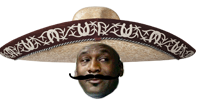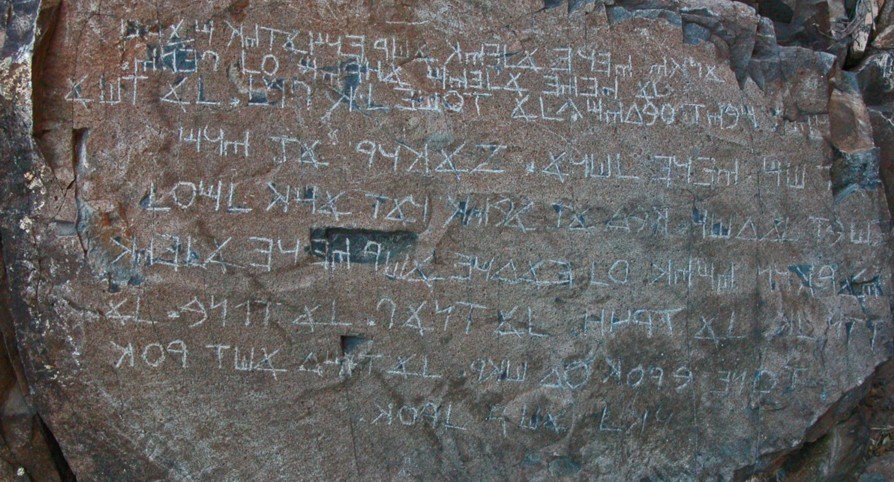The family archive of Ananiah and Tamut[edit]
The eight papyri contained at the
Brooklyn Museum concern one particular Jewish family, providing specific information about the daily lives of a man called Ananiah, a Jewish temple official; his wife, Tamut, an Egyptian slave; and their children, over the course of forty-seven years. Egyptian farmers discovered the archive of Ananiah and Tamut on Elephantine Island in 1893, while digging for fertilizer in the remains of ancient mud-brick houses. They found at least eight papyrus rolls which were purchased by
Charles Edwin Wilbour. He was the first person to find
Aramaic papyri. The papyri have been grouped here by topic, such as marriage contract, real estate transaction, or loan agreement.
[19]
Marriage document[edit]

Marriage Document of Ananiah and Tamut, July 3, 449 BCE,
Brooklyn Museum
Ancient marriage documents generally formalized already existing relationships. In this case, Ananiah and Tamut already had a young son when the document was drawn up. Because Tamut was a slave when she married Ananiah, the contract has special conditions: usually, it was the groom and his father-in-law who made Jewish marriage agreements, but Ananiah made this contract with Tamut's master, Meshullam, who legally was her father. In addition, special provision was made to free the couple's son, also a slave to Meshullam; perhaps Ananiah consented to the small dowry of either 7 or 15
shekels (the text is ambiguous) in order to obtain his son's freedom. Future children, however, would still be born slaves. In contrast to Jewish documents like this one, contemporaneous Egyptian marriage documents were negotiated between a husband and wife.
[20]
Deed of Emancipation[edit]
Nearly twenty-two years after her marriage to Ananiah, Tamut's master released her and her daughter, Yehoishema, from slavery. It was rare for a slave to be freed. And though a slave could marry a free person, their children usually belonged to the master. As an institution, slavery in Egypt at that time differed in notable ways from the practice in some other cultures: Egyptian slaves retained control over personal property, had professions, and were entitled to compensation. During the
Persian Period in Egypt, it was not uncommon to sell children, or even oneself, into slavery to pay debts.
Real estate documents[edit]
Bagazust and Ubil sell a house to Ananiah[edit]

Property Sale Document: Bagazust and Ubil Sell a House to Ananiah, September 14, 437 BCE
Brooklyn Museum
This document to the right describes a property purchased by Ananiah, twelve years after his marriage, from a Persian soldier named Bagazust and his wife, Ubil. The property, in a town on
Elephantine Island, named for the god
Khnum, was located across the street from the Temple of Yahou and adjacent to the Persian family of Ubil's Father. As such proximity might suggest, the Egyptians, Jews, and Persians in Elephantine all lived among one another. The renovation of the house and its gradual transfers to family members are the central concerns of the next several documents in Ananiah's family archive.
[21]
Ananiah gives Tamut part of the house[edit]
Three years after purchasing the house from Bagazust and Ubil, Ananiah transferred ownership of an apartment within the now renovated house to his wife, Tamut. Although Tamut thereafter owned the apartment, Ananiah required that at her death it pass to their children, Palti and Yehoishema. As with all property transfers within a family, this gift was described as made "in love". Image of document in gallery.
[22]
Ananiah gives Yehoishema part of the house[edit]
Drawn up thirty years after the preceding papyrus, this document is one of several that gradually transferred ownership of Ananiah and Tamut's house to their daughter, Yehoishema, as payment on her dowry. The legal descriptions of the house preserve the names of Ananiah's neighbors. They included an Egyptian who held the post of gardener of the Egyptian god
Khnum and, on the other side, two Persian boatmen. Image of document in gallery.
[23]
Ananiah gives Yehoishema another part of the house[edit]
For his daughter Yehoishema's dowry, Ananiah had transferred to her partial ownership of the house he shared with Tamut. After making more repairs to the building, Ananiah transferred a further section of the house, described in this document, to the dowry. Image of document in gallery.
[24]
Ananiah and Tamut sell the house to their son-in-law[edit]
This papyrus records the sale of the remaining portion of Ananiah and Tamut's house to Yehoishema's husband. Possibly because the clients were dissatisfied with something the scribe had written, at one point the text of the document breaks off and then starts over again, repeating what has gone on before with some additions. The boundary description included here refers to the Temple of Yahou in Elephantine, now rebuilt eight years after its destruction in 410 BCE during a civil war conflict that arose out of a land dispute. Image of document in gallery below.
[25]
Loan agreement[edit]
Sometime in December 402 BCE, Ananiah son of Haggai borrowed two monthly rations of grain from Pakhnum son of Besa, an
Aramean with an Egyptian name. This receipt would have been held by Pakhnum and returned to Ananiah son of Haggai when he repaid the loan. No interest is charged but there is a penalty for failing to repay the loan by the agreed date. The receipt demonstrates that friendly business relations continued between Egyptians and Jews in Elephantine after the expulsion of the Persians by
Amyrtaeus, the only
pharaoh of the
Twenty-eighth Dynasty of Egypt. Image of document is in gallery below.
[26]
 bombastic as they may be I've never actually disagreed with them in passing
bombastic as they may be I've never actually disagreed with them in passing



















